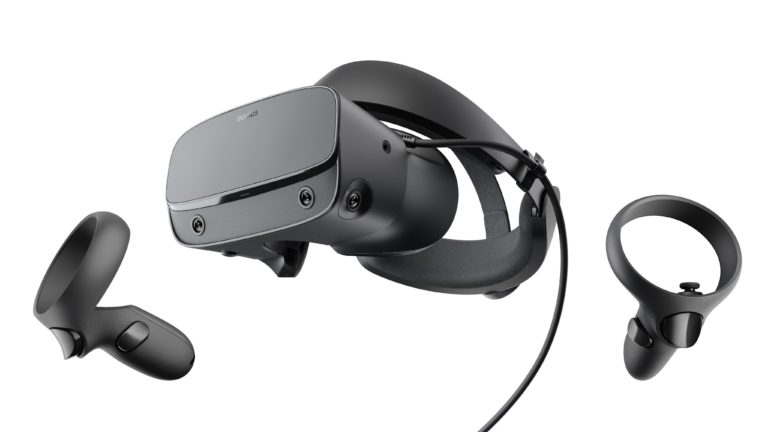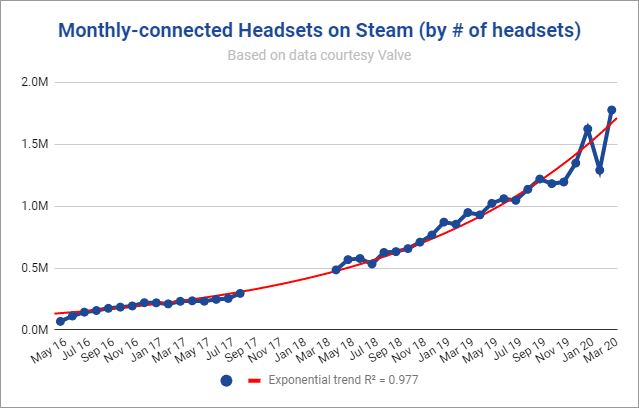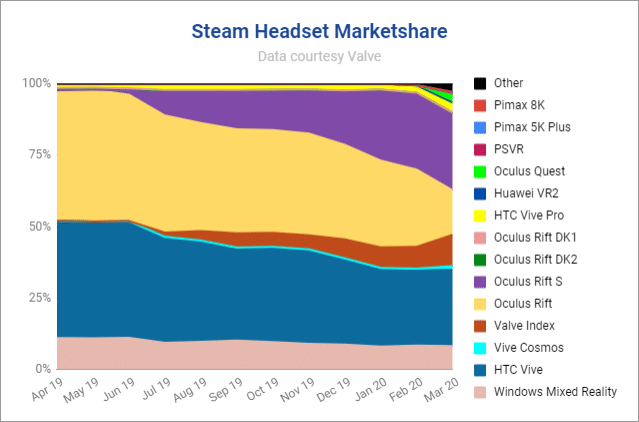
Data Point of the Week is AR Insider’s dive into the latest spatial computing figures. It includes data points, along with narrative insights and takeaways. For an indexed collection of data and reports, subscribe to ARtillery Pro.
AR Insider readers know that we’re obsessed with collecting clues for VR hardware penetration. Because hardware sales figures aren’t disclosed (except from Sony), this becomes an ongoing exercise in piecing together known quantities to extrapolate unknown ones.
Those known quantities include things like Facebook earnings, VR game sales, ARPU metrics, and even directional indicators like the growth in user reviews. Each of these thought exercises gets us to stronger levels of confidence in triangulating reliable VR headset penetration.
The latest set of clues come from Steam, which reports that 1.29 percent of users on its platform used a VR headset in March. Road to VR did some extra digging around total Steam users — now exceeding 100 million — to correlate total headsets on the platform at 1.7 million.

Comprehensive Tally
As, background Steam has always reported monthly figures for VR headsets — a total that continues to slowly rise, per the above chart. But starting in March, it changed its methodology to track a given headset’s use anytime during the month, not just at the moment of analysis.
This results in a more accurate and comprehensive tally of headsets that have been present on Steam in a given month, and therefore how many headsets are on the platform. This in turn can be a signal, or a clue per the opening comments, to extrapolate total VR headsets in-market.
Of course this isn’t perfect, as not all VR users access Steam in a given month. Furthermore, Steam itself represents a subset — albeit a large one — of the PC VR galaxy, which is in turn a subset of the VR universe. For example, it doesn’t fully reflect PSVR, nor Oculus Quest.
But despite those caveats, this is still useful data. For one, this portion of the market can help us extrapolate the whole thing, using educated multiples based on market shares. Second, this subset’s growth over time is proportionately relevant for the broader VR market’s growth rate.

Gut Check
For a further gut check, ARtillery Intelligence has estimated 25-million VR headset in-market (see below) — obviously larger than 1.7 million. But segmenting just PC-VR headsets, it estimated a 3.45 million installed base. That’s about 2x the March active Steam count, which makes sense.
In other words, it’s reasonable to surmise that half of the PC-VR headset base is active on Steam in a given month. Again, not all PC-VR headsets use Steam. And those that do aren’t necessarily monthly active users. There’s a portion of the VR installed base that’s inactive or infrequent.
It also should be qualified that PSVR and Oculus Quest — cited above as not being reflected in Steam figures — do represent a small share use. Quest can access Steam through Virtual Desktop Streaming and PSVR can do so via third-party drivers. But these shares are nominal.
For a further breakdown of the per-headset takeaways and trending on Steam, here are a few highlights, care of Road to VR.
— Valve’s Index has surpassed all WMR headsets in use on Steam (10.94% vs. 8.28%)
— Oculus Quest has surpassed Vive Cosmos (2.89% vs. 1.25%)
— Oculus Rift S is the single most popular headset in use on Steam, surpassing the original HTC — Vive (27.05% vs. 26.67%)
— Oculus Rift (CV1) was overrepresented in earlier data; collectively all consumer Oculus headsets now account for 45.50% on Steam (53.73% previously)

Moving Target
We’ll qualify the above by saying that it’s valuable, but not definitive in pinpointing the VR headset installed base. It’s about extrapolating ranges for a better sense of market levels. These exercises also help inform official figures to come from our research arm, ARtillery Intelligence.
Given the challenge of market sizing without first-party data from VR hardware providers (except Sony), it’s about constantly collecting clues like this, and building smart financial models. It’s like a Sudoku board: using known quantities to logically devise unknown ones.
We’ll continue our unhealthy obsession with assembling reliable inputs and reporting back what we find. Tracking these clues is important, not just to help buttress the market-sizing of our research arm, but to impart an ongoing sense of VR traction and its strategic implications.
See more about ARtillery Intelligence market-sizing methodology here.
For deeper XR data and intelligence, join ARtillery PRO and subscribe to the free AR Insider Weekly newsletter.
Disclosure: AR Insider has no financial stake in the companies mentioned in this post, nor received payment for its production. Disclosure and ethics policy can be seen here.
